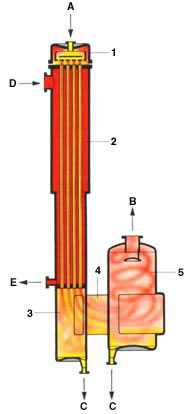Falling Film Evaporators
Falling Film Evaporators
The Falling Film Evaporators can be operated with a low temperature difference and since the product residence time is very less, they are best suited for liquids which are temperature sensitive, have a high rate of specific heat transfer, particularly for non-crystalline solutions. Having low liquid holding volumes, the falling film evaporators are very easy to operate, clean and are extremely sturdy, thus the most frequently used types.
Caution must be used to ensure a continuous film wetting rate and to prevent nucleate boiling, otherwise the rate of heat transfer will fall off dramatically, and the rate of fouling on the heat transfer surface will increase.
In falling film evaporators the liquid product (A) usually enters the evaporator at the head (1) of the evaporator. In the head, the product is evenly distributed into the heating tubes. A thin film enters the heating tube are it flows downwards at boiling temperature and is partially evaporated. In most cases steam (D) is used for heating the evaporator. The product and the vapor both flow downwards in a parallel flow. This gravity-induced downward movement is increasingly augmented by the co-current vapor flow. The separation of the concentrated product (C) form its vapor (B) is undergoing in the lower part of the heat exchanger (3) and the separator (5)


A: Product
B: Vapor
C: Concentrate
D: Heating Steam
E: Condensate
1: Head
2: Calandria
3: Calandria, Lower part
4: Mixing Channel
5: Vapor Separator
Falling film evaporators can be operated with very low temperature differences between the heating media and the boiling liquid, and they also have very short product contact times, typically just a few seconds per pass. These characteristics make the falling film evaporator particularly suitable for heat-sensitive products, and it is today the most frequently used type of evaporator.
Falling film evaporators are used extensively in chemical process industry, food and paper industry. Due to the absence of static head effect caused by liquid column as in other types of evaporators, evaporation can take place at very small effective mean temperature differences. The temperature difference is typically between 3 – 8C. This is significantly less than in other devices used for evaporation, e.g. forced reboilers or kettle evaporators, here the effective mean temperature difference is between 15 a 30C. The film heat transfer coefficients are in general high and characterised by surface boiling.
The absence of hydrostatic head allows this type of evaporator to operate at very low absolute pressures.
Product residence time can be very short, especially in one through the operation. This characteristic of short retention time low operation pressure and small required effective mean temperature differences makes this type of evaporator particularly suitable for concentration of heat sensitive liquids. The absence of nucleate boiling under normal operation conditions and low temperature differences reduces also possible fouling tendencies.
The flow pattern can be characterised as a liquid annulus with vapour core.
Conclusion:
- In general very high heat transfer coefficients, which can be considerably lower in systems with viscous mixtures.
- Very short liquid residence time in tubes, therefore, low liquid hold-up and inventory
- Small effective mean temperature differences, where evaporation takes place at the liquid surface. In general, it is recommended to avoid nucleate boiling (fouling)
- Pressure drop in tubes is often negligible, therefore, only in vacuum applications the calculated pressure drop has to be taken into account
- Falling Film Evaporators can be operated at very low absolute pressures, they can be used at absolute pressures approaching the hydrostatic head of film thickness
Typical applications :
- Distillery stillage
- Yeast effluent
- Grain wet milling
- Brine concentration
- Abattoir effluents
- Gelatinous wastes
- Black liquor
- Textile industry
- Wool washing effluents
- Oil emulsions treatment
- Pickling bath recovery
- Effluent from chemical reactors and storage tank cleaning
- Ammonium nitrate polluted condensates from reactors
- White waters (waters containing paraffin)
Contact Us At
Address
Paramount Limited, Paramount Complex, Near Natubhai Circle, Race Course, Vadodara, Gujarat - 390007
Phone Number
Vadodara: +91-0265-2397111
+91-0265-6603700
New Delhi: +91-11-26186525, 26186369
Mumbai: +91-22-24078105
Email Address
Vadodara: sales@paramountlimited.com
New Delhi: delhi@paramountlimited.com
Mumbai: mumbai@paramountlimited.com

